What Is An Overlock Machine? Serger Basics And Pro Finishes Guide
Ever wondered how store-bought clothes get those neat, tidy edges on the inside? Often, a special machine called an overlock machine, also widely known as a serger, is the secret.
This simple guide is for anyone new to sewing, hobbyists, or small business owners. We’ll explore what an overlock machine is and how it can give your sewing projects a professional finish. You’ll learn what this machine does, its cool benefits, and how it’s different from your regular sewing machine. Let’s discover how it can make your sewing even better!
1. What exactly is an overlock machine (often called a serger)?
An overlock machine is a special type of sewing machine. Its main job is to finish the edges of fabric. This makes the edges look neat and stops them from fraying (when threads come loose and unravel). Think about the inside seams (where fabric pieces are joined) of clothes you buy from a store; they often have a clean, wrapped edge. That’s the kind of professional finish an overlock machine creates.
You might also hear it called a serger or serger machine. These names mean the same thing as overlock machine or overlocking machine. So, its main purpose is to give fabric edges a clean, durable, and professional look, preventing unraveling.
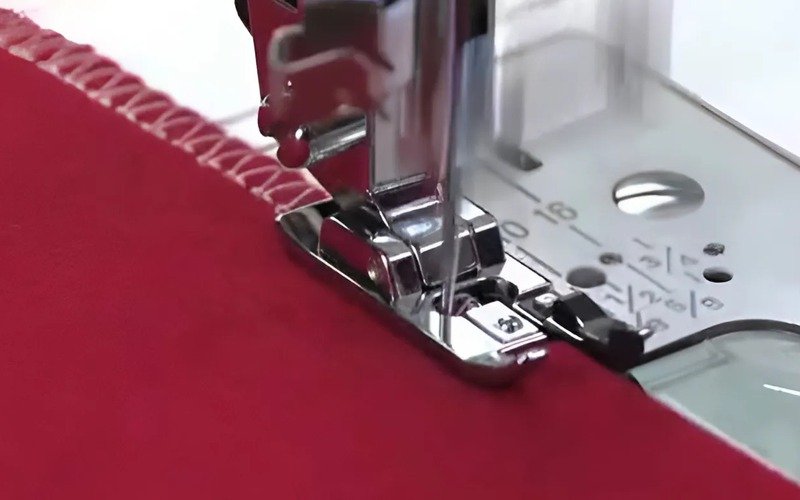
2. The magic trio: what an overlock machine does all at once
One of the coolest things about an overlock machine is that it does three jobs at the same time. This makes sewing faster and neater. Here’s what it does in one go:
- Sews a seam: It joins pieces of fabric together, like a regular sewing machine.
- Trims the fabric edge: It has small cutting blades or knives (an integrated cutting system) that trim away the extra fabric along the edge just before it sews. This creates a perfectly straight and clean edge.
- Overcasts the edge: It wraps threads around the trimmed fabric edge. This is done by special parts called loopers (an upper looper and a lower looper, instead of a bobbin like in regular machines). This action covers the raw edge and prevents fabric fraying. Overlock machines usually use multiple threads – typically 2, 3, or 4 threads at once – to create these loopy, edge-finishing stitches. These multiple threads allow for different types of strong and flexible stitches.
3. Why bother with an overlock? key benefits of using one
Using an overlock machine offers some great advantages for your sewing projects:
- Professional finish: It makes your homemade items look like they came from a store. The inside seams are neat and tidy, a hallmark of professional finish sewing.
- Speed and efficiency: Because it sews, trims, and finishes the edge all in one step, it’s a fast sewing machine. This saves a lot of time compared to doing these steps separately with a regular machine and scissors.
- Strong and durable seams: The stitches created by an overlock are strong yet flexible. This makes them great for items that will get a lot of wear or need to stretch.
- Perfect for stretchy fabrics (knit fabrics): This is a big one! Knit fabrics (like t-shirt material, jersey, or Lycra) are stretchy. Overlock stitches stretch with the fabric. This prevents threads from popping when the fabric is pulled. It’s ideal for t-shirts, leggings, sportswear, and baby clothes.
- Stops fraying completely: By wrapping the fabric edge in thread, it completely stops fabric fraying. This helps your garments last longer and look better.
- Versatility (brief mention): Beyond seams, overlocks can also create lovely rolled hems (tiny, neat edges perfect for light fabrics like scarves) and other decorative edges.
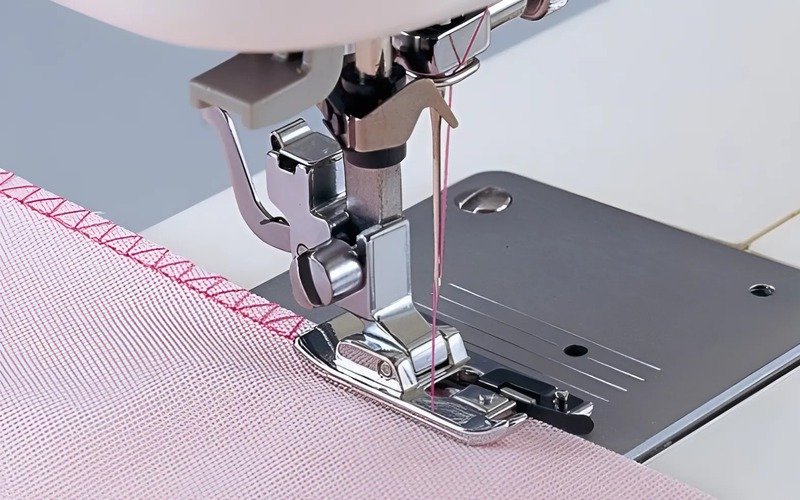
4. Overlock vs. regular sewing machine: what’s the big difference?
Both an overlock machine and a regular sewing machine are valuable tools for sewing. They just do different jobs best. Understanding the difference between a serger and sewing machine helps you know when to use each one.
What an overlock excels at (and regular machine doesn’t usually do):
- It trims the fabric edge as it sews using its built-in knives.
- It wraps the edge with thread using loopers and multiple threads. A regular machine uses a bobbin (a small spool of thread underneath) for its stitches.
- It’s much better for sewing stretch/knit fabrics because its stitches are naturally elastic.
- Its main job is edge finishing, seaming (especially knits), and preventing fraying.
What a regular sewing machine excels at (and overlock can’t do):
- Sewing in the middle of fabric (e.g., straight stitches, basic zigzag stitches for construction).
- Making buttonholes.
- Sewing in zippers (most types).
- Creating topstitching (visible decorative or construction stitches on the outside of a garment).
- Precision piecing for projects like quilting.
Here’s a quick comparison:
| Feature | Overlock machine | Regular sewing machine |
|---|---|---|
| Cuts fabric edge? | Yes, automatically | No |
| Makes buttonholes? | No | Yes |
| Best for knit seams? | Yes, very flexible stitches | Can be tricky, stitches may pop or pucker |
| Uses loopers? | Yes (for overcasting stitches) | No (uses a bobbin) |
| Primary use | Edge finishing, seaming knits, preventing fraying | General construction, zippers, buttonholes |
Conclusion of comparison:
An overlock machine and a regular sewing machine are partners, not replacements. Many sewers use both. For example, you might use your regular sewing machine to install a zipper and do topstitching, and then use your overlock machine to neatly finish all the inside seams.
We often advise new designers that understanding how these two machines complement each other is key to versatile garment construction. For example, using a regular machine for a zipper, then an overlock for finishing the internal seams.

5. What can you actually make or do with an overlock machine?
An overlock machine opens up many possibilities for projects. Here are some common serger projects and overlock uses:
Garments (especially knit fabrics):
- T-shirts, sweatshirts, hoodies: Overlocks create strong, stretchy, and neat seams perfect for sewing knit clothes with a serger.
- Leggings, sportswear, swimwear: The seams need to move with you, and overlock stitches provide that stretch.
- Pajamas, baby clothes: Seams are soft against the skin, durable, and non-irritating.
- Dresses and skirts made from knit fabrics.
Finishing touches (for woven fabrics too):
- Neatening inside seams of jackets, pants, and blouses made from woven fabrics (like cotton or denim). Even if you construct the garment on a regular machine, finishing woven fabric edges with an overlock prevents them from fraying inside.
- Creating beautiful rolled hems on lightweight fabrics for items like scarves, napkins, or ruffles. A rolled hem overlock stitch is tiny and neat.
- Gathering fabric: Some machines have special settings or attachments to create ruffles or gather fabric easily.
Other projects:
- Cloth diapers, reusable pads: Need durable edges that withstand many washes.
- Fleece blankets: Quick and easy edge finishing.
- Home decor items: Finishing raw edges of pillow inserts or curtain panels before final sewing.
Different stitch settings can be used for various needs. For example, a 3-thread overlock stitch is often good for lightweight fabrics or just finishing edges, while a 4-thread overlock stitch provides a stronger seam, great for constructing t-shirts or activewear.
From aspiring fashion designers making their first knitwear line to crafters creating beautiful home textiles, we see the versatility of the overlock in action. The ability to quickly finish edges on both knits and wovens is invaluable.
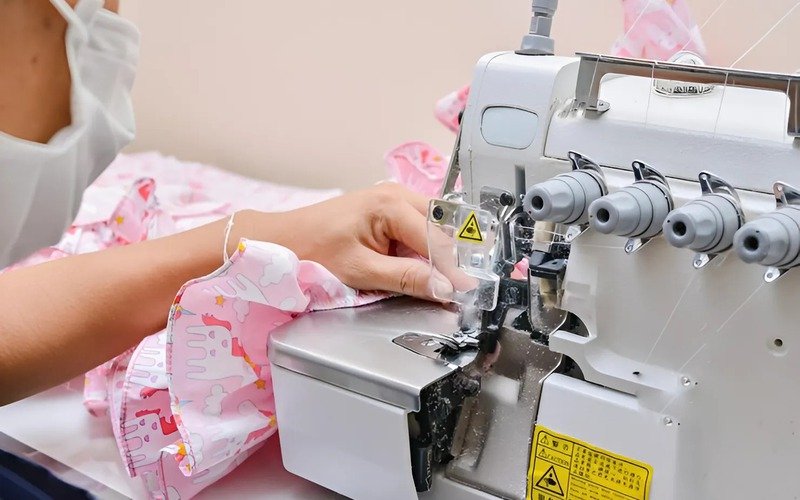
6. A quick peek inside: basic parts of an overlock machine (simplified)
Let’s take a very simple look at the main overlock machine parts or serger components you’ll see:
- Needles: Overlock machines use one or two needles (some specialized ones use more). They are often a special type designed for sergers.
- Loopers (upper and lower): As mentioned, these parts create the thread loops that wrap around the fabric edge. There’s an upper looper and a lower looper, and they work together instead of a bobbin.
- Knives/blades (upper and lower): These are the cutting blades that trim the fabric edge neatly just before the needles stitch.
- Presser foot: This foot holds the fabric down as you sew, similar to a regular sewing machine, but it’s specialized for overlocking.
- Differential feed (very simple): This is a clever feature! Overlocks have two sets of “feed dogs” (the little teeth under the presser foot that move the fabric). The differential feed serger control allows these sets of feed dogs to move at different speeds. This helps prevent stretchy knit fabrics from stretching out or puckering as you sew. It can also be used to gently gather fabric.
- Thread tension dials: You’ll see several dials, one for each thread. These control how tight or loose each thread is. Proper overlock tension settings are important for a balanced, neat stitch.
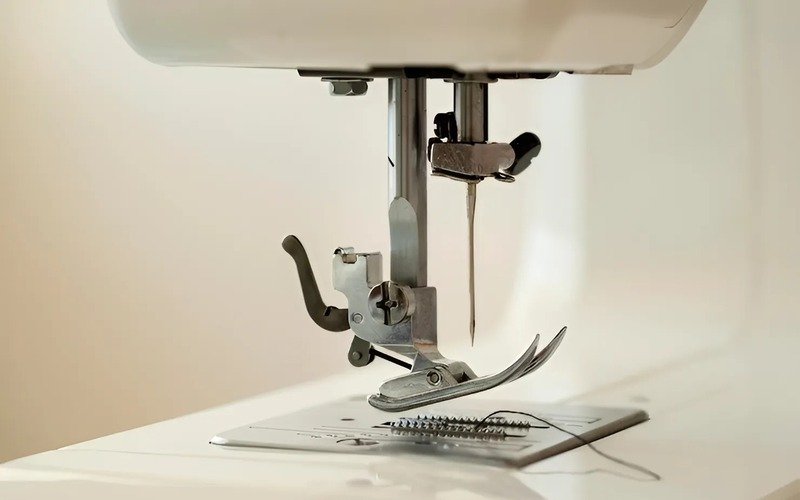
7. Is an overlock machine for you?
An overlock machine can seem a bit intimidating at first, especially when it comes to threading an overlock. It’s true that threading an overlock is different from a regular sewing machine because it uses multiple threads.
However, most modern machines have color-coded threading paths printed right on the machine, and clear diagrams in the manual. With a bit of practice, and maybe watching a few online tutorials, learning to use an overlock and thread it becomes much easier.
So, should I buy an overlock machine? Or is a serger worth it? Consider these points:
- If you sew frequently, especially with knit fabrics.
- If you want a truly professional finish on the inside of your garments.
- If you want to save time on finishing edges and sewing stretchy seams.
If these sound like your goals, then an overlock machine can be a fantastic investment that truly elevates the quality of your sewing.

8. Elevate your creations: adding professional branding to overlocked items
Once you’re creating beautifully sewn items with professionally finished overlocked seams, you might think about the next step: branding. Especially if you’re selling your creations or giving them as high-quality gifts, adding a custom touch makes them even more special.
At Packlove, we specialize in providing custom clothing labels and branding solutions. Here are a few options that work wonderfully with items you’ve made using your overlock machine:
- Custom woven labels: These are perfect for adding your brand logo or name inside garments. They are durable, look very professional, and can be sewn in easily.
- Heat transfer labels (tag-less tags): For items where a sewn-in label might be bulky or irritating (like baby clothes, activewear, or delicate fabrics), heat transfer labels for t-shirts and other items are a great choice. They provide a smooth, tag-less feel.
- Care & content tags: Don’t forget care instruction tags! These tell people how to wash and care for the item, and can include fabric content.
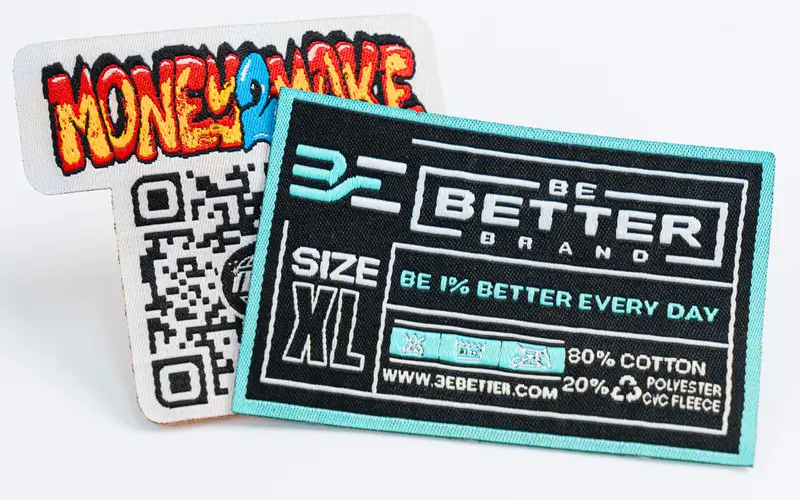
9. Frequently asked questions (FAQs)
9.1 Is an overlock machine the same as a serger?
Yes, they are the same type of machine. Serger is just another popular name for an overlock machine, especially in some parts of the world like the US. Both do the same job: finishing fabric edges neatly
9.2 Do I need an overlock machine if I have a regular sewing machine?
You don’t absolutely need one to sew. However, if you want your clothes and projects to have a very professional look on the inside, make strong and stretchy seams, or if you sew a lot with stretchy knit fabrics, an overlock machine is a very big help. Many people start with a regular sewing machine and get an overlock later as their skills and needs grow.
9.3 Is it hard to thread an overlock machine?
Threading an overlock can look tricky at first because it uses multiple threads (often 3 or 4). But most new machines have color-coded guides printed right on them to help you. It definitely takes some practice, but most people get the hang of it. There are also many helpful videos online that can show you exactly how to thread your specific model.
9.4 What kind of thread do I use for an overlock machine?
You can use regular polyester sewing thread that you use for your normal sewing machine. However, because overlocks use a lot of thread (since they use multiple strands at once), many people buy special ‘serger thread’. This thread for serger machines often comes on large cones, which can be more economical in the long run. The most important thing is to use good quality thread for smooth, strong stitches.
9.5 Can an overlock machine replace my regular sewing machine?
No, an overlock machine generally does not replace your regular sewing machine. They do different jobs. An overlock is fantastic for finishing edges, sewing seams (especially on knits), and preventing fraying. Your regular sewing machine is still needed for many other tasks like sewing buttonholes, inserting zippers, topstitching, and doing general sewing in the middle of fabric pieces. They work best as a team!
Read more:
We hope this simple guide has helped you understand what an overlock machine is all about! Here’s a quick overlock machine summary and serger basics recap:
An overlock machine (or serger) creates neat, strong, and professional edges on fabric.
- It saves time by sewing, trimming, and finishing the edge all in one go.
- It’s especially great for knit fabrics and stops edges from fraying.
- It’s a wonderful partner to your regular sewing machine, not a replacement.
Happy sewing! We hope you feel inspired to explore what an overlock machine can do.






















